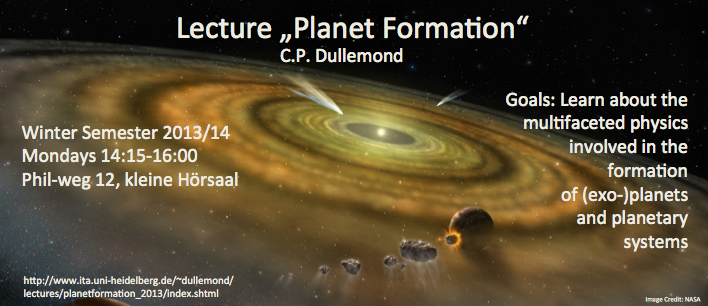Planet Formation (Master/PhD Course: MVSpec)

Wintersemester, 2013/14
C.P. Dullemond
Goals and Topics
The main objectives are to learn about the theory of how we think planets are formed, and what observations we have to constrain these models. The main emphasis is on the physics of planet formation. Topics that will (likely) be covered include:
- Recap of most important solar system properties
- Overview of current state of knowledge of exoplanets and exoplanetary systems
- Meteorites, parent bodies, onion-shell model, chondrules, radioactive dating, 26Al, Pb-U
- Dynamics of planetary systems: Restricted 3-body problem, Hill sphere, horseshoe orbit, Jacobi integral, zero-velocity curves, Tisserand relation, chaos theory, Roche radius, tidal forces
- Protoplanetary disk theory, flaring disk structure, radiative transfer, hydrodynamics, gravitational instability, spiral waves, vortices, magnetorotational instabilities, Rossby wave instability, baroclinic instability, alternative accretion scenarios with global B-fields, magnetospheric accretion, jet launching, disk winds, photoevaporation of disks, transition disks
- First steps of long road from dust to planets: Dust coagulation theory, lab experiments, Smoluchovsky equation, simple one-particle growth models, settling, radial drift, growth barriers (drift, fragm, bouncing, charging), particle trapping. Comparison to observations (Spitzer, Herschel, VLT, ALMA)
- Chemistry of planet formation: ices (evaporation, condensation, organics), O-isotope fractionation, condensation sequence
- Gravoturbulent planetesimal formation: Goldreich and Ward model, streaming instabilities, Kelvin-Helmholtz instabilities, concept of Roche density
- N-Body dynamics of rocky planet formation: Kozai effect, effect of long distance stirring incr e,i, effect of close encounters, mean motion resonances, viscous stirring, dyn friction, runaway growth, oligarchic growth, feeding zone
- Gas giant planet formation, core accretion, models of atmospheres and their instability, circumplanetary disks, Saturn's rings and their formation
- Migration: Lindblad torques, corotation torques, type I,II,III migration, migration traps
- Long term evolution of planetesimal disks: Debris disks, collisional cascades, Poynting-Robertsen, Yarkowski, YORP
- Long term N-Body evolution: migration against planetesimal disks, "Nice" model, "Grand Tack" model, stability analysis, external pertubations
Style of the lecture:
The lecture will mostly be held on the blackboard. However, lecture material will be provided as powerpoint pages.Schedule:
The schedule below is just an estimate and can change:| Date: | Topic: |
| 14.10.2013 | Introduction |
| 21.10.2013 | Disk Formation |
| 28.10.2013 | Viscous accretion disks |
| 04.11.2013 | Structure of protoplanetary disks |
| 11.11.2013 | Turbulence in disks |
| 18.11.2013 | Dust coagulation and dust motion |
| 25.11.2013 | The restricted 3-body problem |
| 02.12.2013 | Gravoturbulent planetesimal formation and particle trapping |
| 09.12.2013 | Formation of rocky planets I |
| 16.12.2013 | Formation of rocky planets II |
| 13.01.2014 | Formation of gas giants |
| 20.01.2014 | Planet-disk interaction, migration, resonances |
| 27.01.2014 | Long-term evolution of planetary systems |
Material:
This material is no longer available online.
Responsible: Simon Glover, last modification Jan/12/2017 23:23 CET

 Home page
Home page